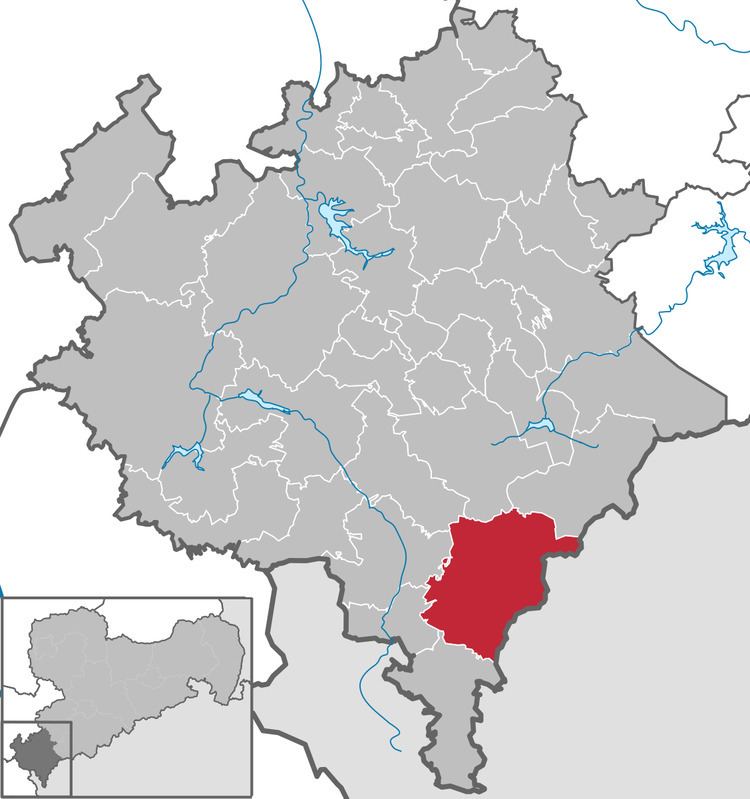Time zone CET/CEST (UTC+1/+2) Area 47.38 km² Local time Monday 11:06 AM | Elevation 504 m (1,654 ft) Postal codes 08258 Population 6,771 (31 Dec 2008) Postal code 08258 | |
 | ||
Weather 4°C, Wind S at 11 km/h, 61% Humidity | ||
Markneukirchen is a town in the Vogtlandkreis district, in the Free State of Saxony, Germany, close to the Czech border. It lies in between the Erzgebirge and the Fichtelgebirge in the Elstergebirge, 24 km (14.9 mi) southeast of Plauen, and 14 km (8.7 mi) northeast of Asch (Czech Republic).
Contents
- Map of Markneukirchen Germany
- History
- Local government reorganisation
- Coat of arms
- Partner towns
- Museums
- Public transport
- Education
- Notable people
- Literature
- References
Map of Markneukirchen, Germany
Markneukirchen is the main town of the small musical instrument-making region, known for four centuries for high quality brass and string instruments. Within this small locality, 113 different enterprises are involved in making musical instruments. They rely on traditional methods but sell all over the world.
The town is home to the Museum of Musical Instruments founded in 1883 by Paul Otto Apian-Bennewitz. It hosts an annual International Instrumental Competition and master classes. [1] Since 1993 the competition has been a member of the World Federation of International Music Competitions. Arnold Voigt worked in the town for most of his life.
History
Nothaft: In the 13th century, the new village was established and took the name of the local Egerland nobility: Albertus Nothaft de Wildstein, who was occupying the area and moving in families from Bayern and Oberpfalz. In a deed from a century later, 1378, it was referred to as Nuwenkirchen dictum Nothaft.
Around 1274 the name was first recorded as Neukirchen (new church). The new church building was mentioned in a deed from Klosters Waldsassen, as Chunradus de Newenkirchen.
In 1357 (Nuenkirchin) and 1360 (stat) the place gained a market with the same rights as the neighbouring towns of Adorf und Oelsnitz. The market was founded by Vögte von Plauen (either Heinrich der Ältere or Heinrich der Lange), who used it to establish a higher place in the pecking order, in their struggle with the Wettiner dynasty.
The town's instrument-making history stems from the 17th century arrival of a group of Protestants fleeing religious persecution across the border in Bohemia. Among them were some who already practised the instrument trade. By the 1900s, 80 percent of the world's musical instruments were made in this small town.
Under communist rule, the businesses in the town were reorganised collectively. The state managed trade with the outside world, and decided a production schedule for the instrument makers at the start of each year, rendering it a useful foreign-exchange income.
The present spelling Markneukirchen, that is Mark without a t, was fixed in 1858 by royal decree from Dresden, so it would not be confused with other Neukirchens.
Local government reorganisation
In 1994 Wohlhausen and Breitenfeld were subsumed into Markneukirchen (on January and 1 March, respectively), and Landwüst joined in 1999. Erlbach became part of Markneukirchen in 2014.
Coat of arms
The arms share with Plauen und Adorf the motif of the Plauen Vögte, that is a left-facing lion with doubled tail and aggressive tongue.
Partner towns
Museums
Public transport
Markneukirchen's first railway station was on the Chemnitz-Aue-Adorf Line near Siebenbrunn. In 1909 the Stichbahn railway from Siebenbrunn to Erlbach opened with a station near the post office and in the town centre. This closed in 1975 and Siebenbrunn on the Vogtlandbahn became the nearest station again.
